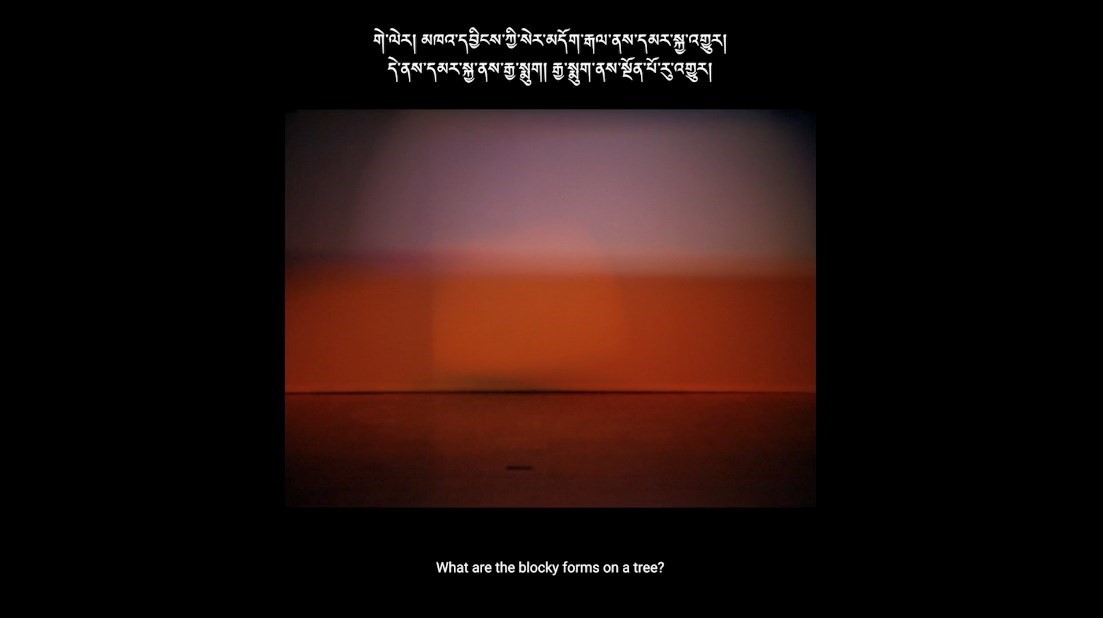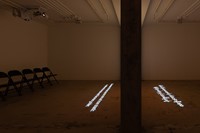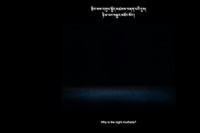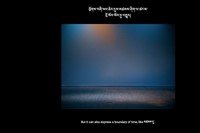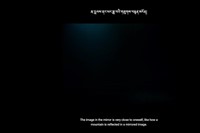Art In Relation: how can art allow human beings to live together sustainably and in relation to one another? In this series, Chinese-Canadian curator and writer Kate Wong speaks to artists working across performance and film about the role of storytelling in their practices, and about creating work that allows us to come together in a world that tries its very best to keep us apart.
Shen Xin creates moving image installations and performances that empower alternative histories and narratives. Examining how emotion, judgement and ethics are both produced and articulated through subjectivity, their work focuses on the complex interpersonal and political narratives that govern contemporary life. Offering up the opportunity to reflect and to seek spaces of belonging, their practice embraces the multiplicity of identity, exploring the potential relations that exist outside of nationalistic belonging.
་གཞི་སྔོན་པོ་འགྱུར། (The Earth Turned Green) is a multi-channel film installation that centres restorative practices drawn from the Tibetan language. Consisting of a three-channel video and sound installation, this new commission – currently on view in the artists solo exhibition at Swiss Institute in New York, curated by Alison Coplan – is conceptually and visually layered in its approach to thinking through performativity, land and family histories. The work was created together with lighting technician Kyle Gavell and Shen’s Tibetan teacher and PhD candidate སྐྱིད་དར་འཛོམས། Ji Ta Zong.
In the development of the work, Shen first wrote directions for Gavell to develop a durational lighting installation inside an unused theatre, that would represent a day’s passing in each of the four seasons. The artist then transcribed what they saw visually on stage into a text in Mandarin, which was then translated by Ji into Tibetan. This translation served as the foundation for a series of twelve Tibetan language lessons during which Shen and Ji, in both Mandarin and Tibetan, discuss the collaboratively-formed text in a philosophical and nuanced manner.
ས་གཞི་སྔོན་པོ་འགྱུར། (The Earth Turned Green) as both an installation and performance poses questions around the fluid impermanence of language and what can arise within the processes of translation, especially when there are multiple perspectives involved. Shen’s work opens up their own personal and family history and roots it within a polyphonic context, one that allows for healing and the formation of new connections. Drawing from Shen’s text, in this process: they merge together, one cannot tell where one starts or where the other ends.
Kate Wong: The text you wrote describing the lighting you developed with Kyle Gavell is incredibly beautiful – more poetic than a literal recounting. What was the writing process like?
Shen Xin: There is something similar between working collaboratively with another person who might be a specialist of some sort, and working with language, be it in mother tongue or otherwise. The similarity has to do with understanding what you won’t be able to convey, control or predict. What was clear to me was imagery of seasons, to present them durationally, to paint a day’s passing with light. And to paint it with someone who specialises in theatre lighting in this specific place, The College of Saint Benedict and Saint John's University, a university negotiating their relationship with the land on which it stands – homelands of the Dakhóta and Anishinaabe peoples.
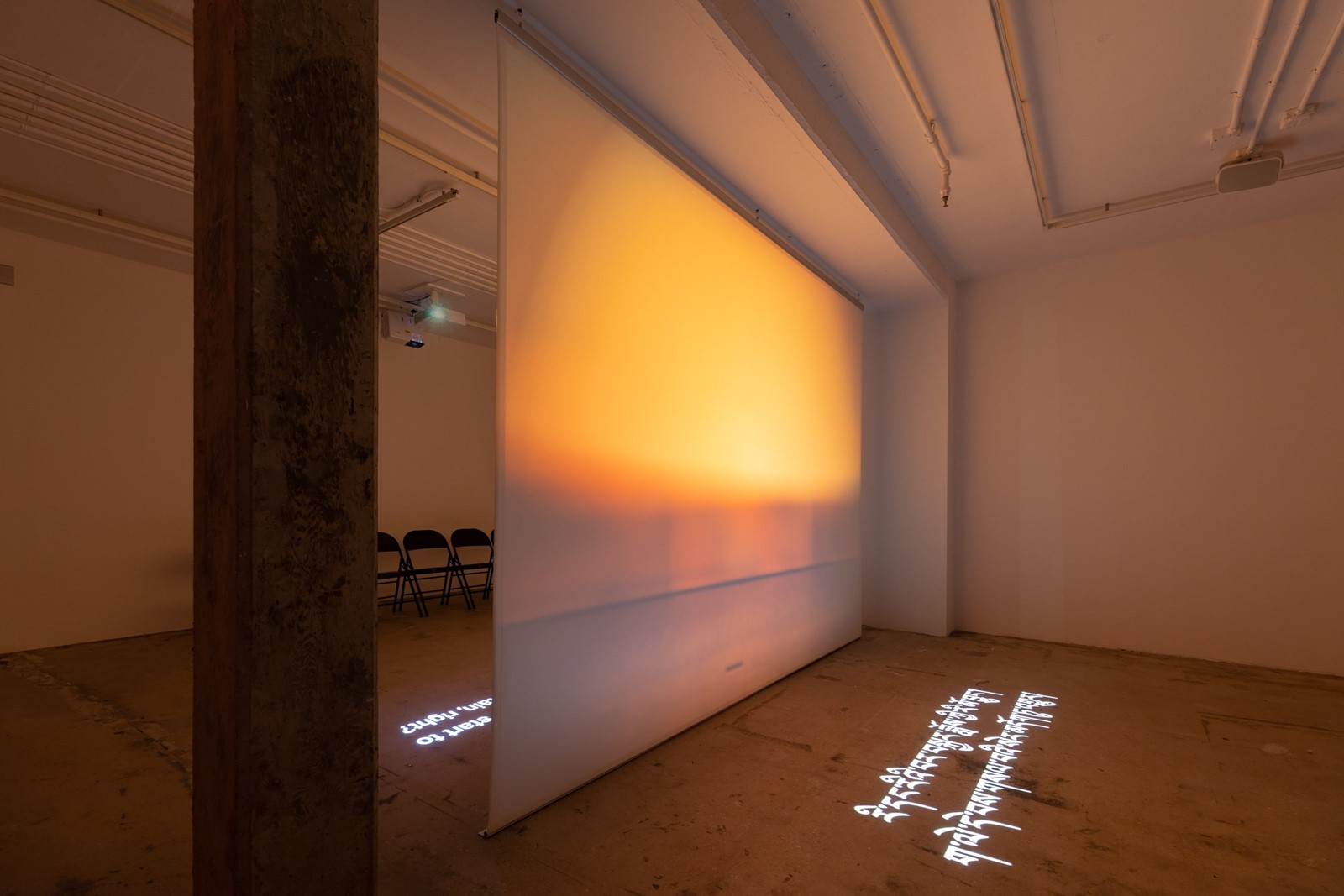
To imagine one’s relationship with time, the effect of time, on any contested ground, is potentially restorative for one’s relations. One is simultaneously a participant and an audience, for the need to be a part of it is unquestionable. The same is with language, to utter is to observe the utterance, how it’s been through construction and deconstruction, one retains the unknown of how language came to be at this present moment. Therefore writing becomes relational to gravity.
First it acted like recipes of one day in each season, consisting of colours, directions, movements to be tested for the collaborative efforts, during which the exchanges between two (Kyle and me) are about giving and making pathways. To be stubborn in those moments risks betraying the natural reaction of the gut when one’s falling, and to fall is often not dissimilar to flying.
The poetic text you mentioned that is in the video as subtitles and teaching materials for Tibetan language, is made after the theatre images. Transduction is at the core of these processes, to change and create while translating. There’s liberty taken to manifest something new each time, and always from a place of respect towards the unknown in time’s effect and meaning, the interbeing of image and language held by more than one.
“To be stubborn in those moments risks betraying the natural reaction of the gut when one’s falling, and to fall is often not dissimilar to flying” – Shen Xin
KW: Why did you decide to set this within an empty theatre, and how did it develop into a three-channel video and sound installation?
SX: Theatre has been a reoccurring language in my practice, as it makes obvious the intentionality of performativity. At the same time it describes the distance between representation and reality. The separation of text from image in the installation references a long-held interest in the capacity of text and images working together, contrary to focusing on their differences and incompatibility. The installation separates the text from the image in the way that they are intentionally dependent on each other, being the reference of context. The audio is in Mandarin and Tibetan, it can be heard on both sides of the screen that’s positioned in the middle, separating the space into two parts. The English subtitles are projected on the floor on the rear side of the projected image, which for me personally alludes to the ‘backstage’. The Tibetan subtitle is not of an explanatory nature, it accompanies the image’s front side as if they were paintings shifting in time.

KW: Who are some of your favourite artists working in film or filmmakers? And have you watched anything recently that has really stayed with you?
SX: This shifts and is sometimes inconsistent, but Lee Chang-dong has always been one of them. Recently, I watched a few films that stayed with me: Poetry (2010), M (2018), There is No Evil (2020), On Horses and Men (2013), MAAT (2020), O Fantasma (2000), Bird Island (2019), I Like Life A Lot (1977), Wheel of Fortune and Fantasy (2021).
KW: You’ve said that ས་གཞི་སྔོན་པོ་འགྱུར། (The Earth Turned Green) “centres restorative practices drawn from Tibetan language through performance, land and family histories”. Can you tell me more about these functions within the work?
SX: The motivation for studying Tibetan has to do with my family history, hence the restorative practice concerns restoring the unknown, that were made known after my father’s death, of our Tibetan ancestry, and the potential motivations behind his obsession with painting Tibetan portraits and figures, as well as going to Tibet as often as we could. My antagonistic perspective towards his practice was then also rendered a missed chance, to be supportive of my kin, of his search towards his kin. The unknown, in this sense, is also much more pervasive if we are speaking to the loss of relations with a multitude of identities. What it means to be a citizen in the name of a nation-state consists of a non-consensual reductive practice, and significant disrespect towards time. Hence for me to learn the language, as part of a node constituting the cycle of the unknown, is held within the intention of restoring the possibilities of the multitude.
The performance language, be it theatre or recording, lighting or questioning, is there to acknowledge the health of distance to be holistic, within the bounds of desires, since claims from subjectivities are often inherently violent. Our relationship with land, an ever-developing and self-correcting one, is for me the most urgent and ideal place to understand possibilities through accountabilities of oneself, being a student, a child, or an artist.
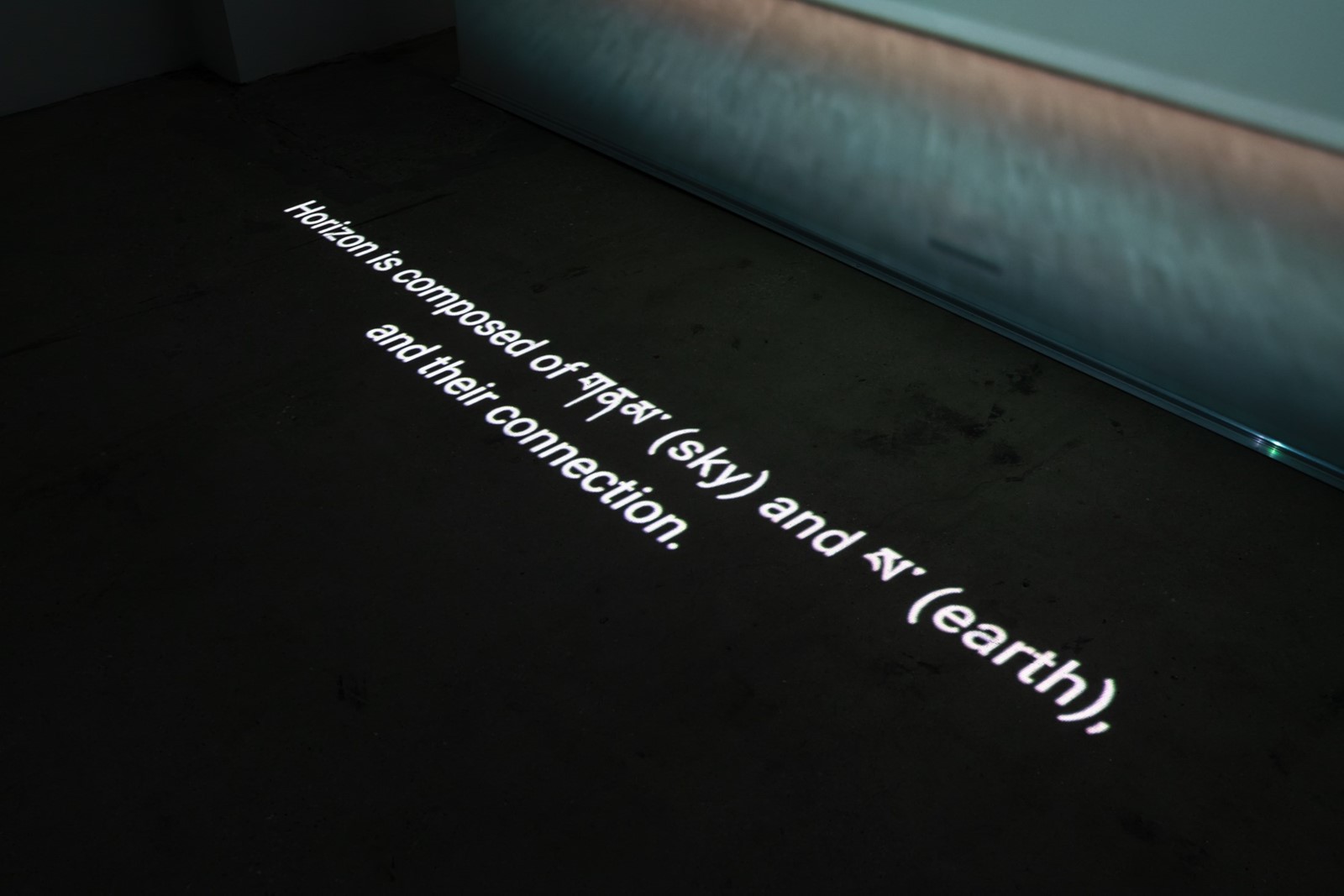
KW: At the beginning of the work you say to your teacher that you’ve looked up a particular Tibetan word [ནམ་མཁའ་], and that part of this word indicates ‘sky as a space’. Your teacher responds by saying that it is also about time. If the sky can be considered as space and time – as having permanence – how can we consider language, in relation to the notions of permanence and impermanence?
SX: I sense that one should approach language knowing that it is both an acknowledgement towards permanence, in the desiring realm, and an affirmative act towards impermanence – for language is to be uttered, written, used. Actions, being part of what manifests relations, partially determines the productivity and the failures of misunderstandings. One is often tested in one’s capacity to hold multiple truths, which again for me has to do with the accountabilities of creating. But if some things are allowed to be permanent, for one to be attached to, like, the sky, as a dwelling, those truths are set in stone, and therefore become safety. This again falls into the unknown, falls into it like gravity forced flapping, towards what is visible of the sky and beyond. The difference is that with language, as creation, obsessions can take root in ways that require a different set of measurements towards time, and being aware of the chances and turns taken within.
“The motivation of studying Tibetan has to do with my family history, hence the restorative practice concerns restoring the unknown, that were made known after my father’s death” – Shen Xin
KW: Following a discussion of the different peoples of the Tibetan Plateau, your teacher reads a line from your text: ‘they merge together, one cannot tell where one starts or the other begins’. Beyond a description of light, seasons and time – or the diverse but interconnected communities she describes – does this sentiment hold further significance for you?
SX: I definitely struggle with this line, for it inherits truth and depicts a phenomenon. I have been drawn to thinking about ethnicity in relation to China as land, from my lived experience on Turtle Island (North America). If the majority is a construction for the sake of the nation-state, in this case, the Han people facilitated the merging of the past in multiple violent chapters, a sacrifice is forced upon oneself. At the same time, I’m not advocating for the ability to tell each other apart, for that alludes to, on that land, time contested. I place significance into not knowing, for it deserves the same chances, to see through the lens of abundance and to experience as active as the known.
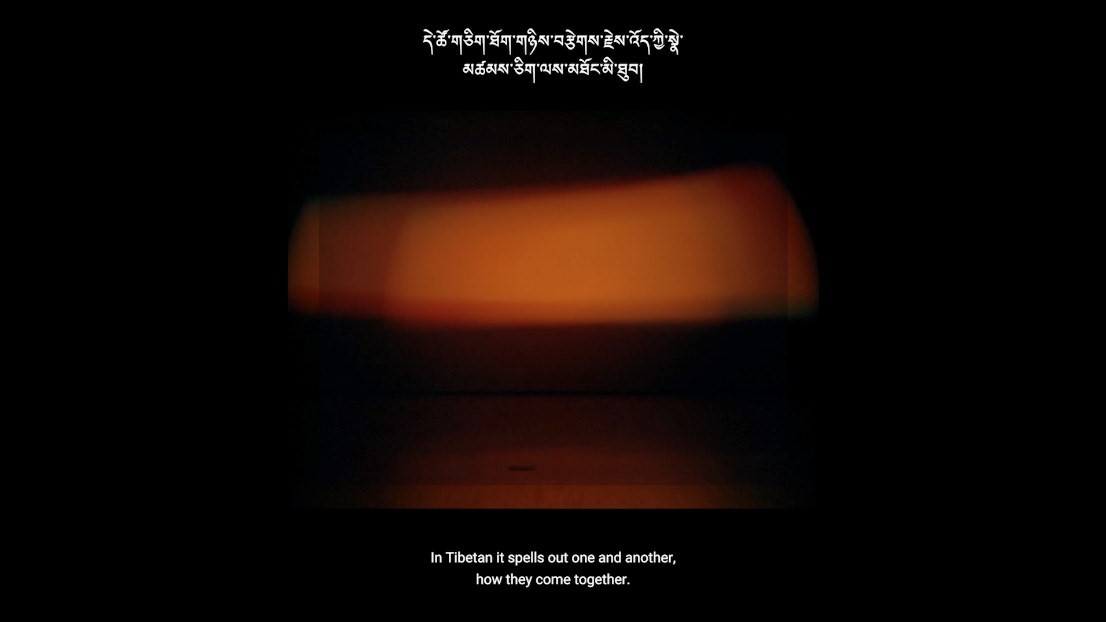
KW: It’s evident that you have done a lot of research into the Tibetan words that make up the text you’ve written. Can you tell me a bit about this process? From writing the text in Mandarin to preparing for your lessons with your teacher?
SX: It has been a more than a difficult journey, but an extremely committed one. Ji translated my text from Mandarin to Tibetan in her own time. The lessons we shared together are made up of Ji reading, explaining word by word, followed by my questions. After each lesson, I spent hours daily going through each word with dictionaries and calligraphy practice, and noted down my other questions to bring to the next class. The reading follows this process, which then became recordings too.
KW: You’ve mentioned the ecological culture of the Tibetan language, and your conversations with your teacher touch on subjects such as the moon, snow, blood, as well as the significance of the human ear within Tibetan culture. Can you speak more about this and why it is of interest to you?
SX: The most satisfying way of being alive for me is knowing that relations obtained are sincere. Where sincerity is concerned in one’s relationship with the moon, snow, blood and body parts, there is the collapse of integrity. One can say it becomes flat, therefore creating a plane on which one stands and senses the interconnectivity of an ever-evolving cycle. You can describe it as a technology too, a preferred one, a dwelling that can be returned to. I don’t think it is unique to the Tibetan language to retain traces of this technology’s presence in time. I believe some are perhaps harder to see, but require looking deeply in the case of other languages as well.

KW: How much did you consider your audience when making this work, if at all? Especially in relation to what languages they speak or have access to.
SX: In this particular installation the image is rear-projected, which means the audience who speaks and reads English are positioned at the back of the image, though visible on both sides. However, the subtlety is there when the text describes directions, such as from left to right – the back of the image would portray the opposite. The backstage in relation to the stage on screen is a constructed reality.
KW: How do you think we as human beings can learn to live further in relation to one another and the earth?
SX: Being relational, for me, means to manifest abundance in the affirmation and negation of potentials (or “to manifest the abundance of potential in both affirmative and negative spaces”). This practice has been most reliable when it demands a shift in the paradigm, of thinking, perceiving, speaking and acting. In recognising each being and how they interconnect, spaces with all characteristics could take on affirmative meanings. This concerns love, it is unconditional because of the interconnectivity, it is conditional due to the demand of recognition, facilitating the full circle, made up of many nodes.
Shen Xin’s exhibition ས་གཞི་སྔོན་པོ་འགྱུར། (The Earth Turned Green) is at the Swiss Institute in New York until August 28, 2022.
